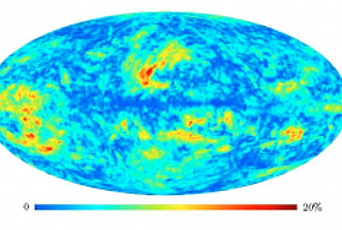Curiosities: Light’s Revelations and Mysteries

Light is the great unifier. John Wheeler, the beloved Princeton physicist, used to draw the universe as a big capital U with a little eye on one leg, signifying that we, human beings, are the eyes of the universe looking back at itself. The universe after many, many billions of years formed human life on planet Earth, and we use light to observe and understand the universe.
The growing understanding of the nature of light through the centuries is the perfect metaphor for science: it is an eye-opener. Almost 350 years ago, Isaac Newton, as a young man, put a prism in a beam of light and unraveled its various colors. This was the beginning of a long story. Around the year 1800, the astronomer William Herschel was the first to measure the temperature of light. He made the startling discovery that the rainbow does not stop at red, but actually continues, invisibly, as infrared light, which we cannot see but can feel as a sensation of warmth.
What is light? Physics has a simple answer: an electromagnetic wave. Exactly 150 years ago, the Scottish physicist James Clerk Maxwell discovered the laws that describe these waves. I have a T-shirt with these equations and the text “And then there was light.” If only Maxwell had patented his equations! It would be enough to finance all research in the world.
Maxwell’s theory is the first and finest example of unification: electricity and magnetism bound together in a single formula. There is a good reason his portrait hangs in Einstein’s study, together with Michael Faraday’s. Suddenly, light was connected to lightning, batteries, and magnets. Now we can add to this radio, television, wireless internet, microwaves, X-rays, and the complete high-tech industry.
We have learned that the rainbow continues on both ends, in theory even infinitely far. On one end, electromagnetic radiation extends to the very large, from microwaves to the radio waves that curl around the Earth. On the other end, we find the ultraviolet that birds can see, the X-rays that penetrate our bodies, and the gamma rays that can spontaneously produce particles.
Light is the connector between all the physical elements in our universe, and it explains the most basic structures in life. Grass is green because of the way light is absorbed by the chlorophyll molecules in its leaves. Even space and time itself are illuminated by light. One hundred years ago, in November 1915, Einstein discovered his theory of general relativity. He realized that if you put anything—literally anything—in space, space and time will curve, and that gravity manifests itself through these curvatures. The famous 1919 experiment, which proved his theory and made him famous, used a solar eclipse to measure the warping of starlight through the sun’s gravitational field.
With modern telescopes, we now see this effect in full glory in the sky. We observe how galaxies act as cosmic lenses and distort the images of stars and other galaxies in the most bizarre ways. But the most dramatic way in which the universe shapes light is through its expansion. Astronomers have discerned this phenomenon by noticing that the colors of distant stars are shifted toward the red. Objects that are moving have different colors—this is known as the Doppler effect—and some of these galaxies move away from us so fast that they are in the deep infrared. So the shape of space and time literally colors our universe.
This coloring is most spectacular in the case of the universe’s first light. This light was emitted roughly 380,000 years after the Big Bang, when matter was no longer closely tied together and light could escape. It has been traveling through the universe ever since and can now be detected as microwave radiation. That signal was first detected fifty years ago—the third anniversary that makes 2015 the International Year of Light. Satellites now produce detailed maps of this primordial light, beautiful pointillist paintings cast by the universe.
In fact, light allows us to connect to the very beginning of the universe. By carefully looking at the universe’s first light, we hope to detect the primordial gravitational waves or ripples out of which the universe began. A cosmological theory called inflation tells us that our universe started as a miniature speck of space that expanded to gigantic dimensions. Inflation theory is being tested right now by trying to find these swirls or fluctuations in the universe’s pointillist painting. Last year, a team of researchers announced that they had detected evidence of these quantum fluctuations. While these apparent signals turned out to be galaxy dust, researchers keep looking for these signatures.
These days, Wheeler’s image is more appropriate than ever. By observing light in all its manifestations we can make contact with worlds that are at the outer edge and the very beginning of our cosmos. For the first time in the history of science, we look through our biggest telescopes or biggest microscopes, peering to the end of the universe or the most inner parts of subnuclear particles, and essentially search for the same thing: What is the universe made of?
There are many beautiful ways that architects, designers, and artists shape light. But the universe might be the greatest artist, and nature is at least as imaginative as we are.


